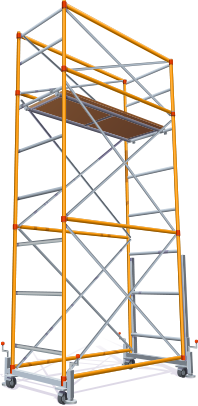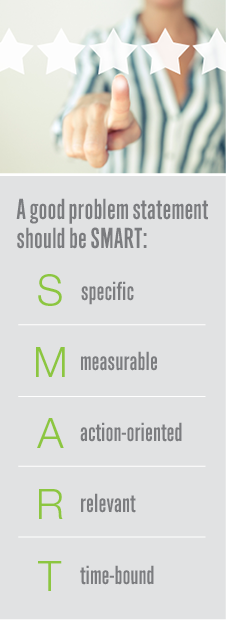Scaffolding strategic projects – giving them the help and support they need
by Dr Marc Levy
Right Thinking
Project success is more important than ever as projects are becoming the default way to get things done within organisations. We’ve found that ‘scaffolding’ project teams – giving them the necessary structural support as they do their important work – can increase the chances of success.

At one of my children’s schools, they talk a lot about scaffolding the children, by which they mean giving them the help and support they need to do their best.
I think that this idea is apposite in a business context too. Having worked on and led more than 500 strategic projects, in my experience, the most successful have generally been well scaffolded.
In this article I share six ideas for scaffolding projects, large and small: overinvest in clarifying the basic objective, contextualisation and aligning leadership; set crystal clear expectations about deliverables, quality and communication; get the right team in place and give them the tools and support necessary to do a good job; build the capability within the team to zoom in and out; review progress in a timely way; and invest properly in project completion and review.
These insights are important now. Projects are becoming the default way to get new things done in organisations and in many of our clients, the lion’s share of budget increases are going to projects.
1. Overinvest in clarifying the basic objective or problem statement, contextualisation and aligning leadership
The basic objective – we typically call it a problem statement in consulting – is the first critical layer of the scaffolding. It should clearly define, in a concise but comprehensive way, the key business problem that needs to be solved, often in the form of a question. A good problem statement should be SMART: Specific, Measurable, Action-oriented, Relevant, and Time-bound.

‘What growth and retention strategies – giving particular attention to pricing, digital direct, and intermediated channels – can we put in place by the end of 2019 in order that by the end of 2020 we have arrested the decline in the Australian market share of our product, X?’
The problem statement should be informed by a thoughtful diagnosis of the problem. Ray Dalio’s provocative question (2017), ‘what is true (today, with respect to the problem)?’, is a good place to start.
We recommend overinvesting in diagnosing and defining the problem statement, for three reasons. First, projects inevitably run more smoothly if there is alignment on the problem to be solved. Second, the problem statement drives the project work and getting it right can stop the team going down blind alleys. Third, carefully crafting the problem statement, in light of the diagnosis, sharpens the team’s thinking and sets the tone for the problem solving that follows.
Context is important for projects and it is critical that projects give it proper consideration. What are the attitudes within the organisation to the project? What are the levels of support for it and how sustainable will they be? What are the processes by which people want to engage with the project? Some of the best project managers that I’ve seen are highly adept at managing the politics of projects within organisations and understanding and attending to context is an important part of this.
Where possible, the organisation’s leadership should be involved in the formative stages of projects. Leadership support and commitment is of course a precondition for success, so having leaders involved in architecting the basic objective or problem statement, or at least signing it off, is a necessary first step for most significant projects.
2. Set crystal clear expectations about deliverables, quality and communication
Project teams often waste a lot of time – their own and the time of their leaders and stakeholders. Clarity relating to deliverables – what must be done, in what form, drawing on which data sources, consulting with whom, by when – can get the team focused and stop the wheels spinning.
Embedding a quality standard in the scaffolding, setting expectations about quality, including structured thinking and attention to detail, is central to successful projects. Poorly structured thinking wastes the team’s time and can derail the project. Slapdash work begets slapdash work.
Most teams know the basics of good project comms and engagement, but they don’t always apply them. People orbiting the project will often assume the worst if there is a project communications vacuum. ‘What are they doing over there? They seem busy, but [big deliverable] is coming up and who knows whether they’ll be ready.’ Worse still, ‘I am ultimately accountable for the success of that project and I haven’t got a clue whether they are on track or not.’
We have three simple suggestions to improve project comms. Send out a Friday email every week, to everyone with an interest in the project, covering what was done this week, what will be done next week, and any issues with scope or timings. If there is no steering group, or if there are important senior stakeholders who are not on the steering group, hold recurrent ‘project threshold issues meetings’ with senior stakeholders so that they can be engaged in the project issues, help the project team remove barriers and get things done. Use design and visualisation techniques to elevate the work (compelling rationale, galvanising insights, simple and clear messages about the project and its promise) and increase its prominence around the organisation.
3. Get the right team in place
‘People are our greatest asset’ can be a glib refrain, but it resonates in project management. A good team is almost always capably led, by someone with sufficient time and energy and for whom the project is a priority, supported by colleagues with the necessary skills and complementarity.
The skills part is obvious – in our world, for example, we need consultants who can structure the work, and others who can break the back of the analysis, shape the storyline and engage the client. Team complementarity is no less important but it is often overlooked. Good project teams need what we call a ‘range of diversities’ – in, for example, background and experience, perspective, style and mindset. As an illustration, we’ve found that project teams need strong problem solvers, empathetic engagers and finisher-completers. In some cases, all the skills required for project success will not be resident within the organisation.
 4. Build the capability within the team to zoom in and out
4. Build the capability within the team to zoom in and out
When contemplating projects that have run into problems I have mental images of hardworking, well-intentioned team members with their heads buried in their computer screens, working late and on the wrong things. Analysis that didn’t get used; unnecessary documentation; project tasks that were relatively unimportant compared with what they could have been doing. These are hallmarks of a failure to zoom out and see the project from the distance necessary to gain proper perspective.
A failure to zoom in is equally problematic. Knowing when to drop down into the detail is a critical skill for project leaders in particular. From managing projects, we’ve found that maintaining a regular dialogue with team members – even daily – gives project leaders the opportunity to ask pointed questions (constructively) and zoom in where necessary, without having to wait for project deliverables that can be days or weeks away.
5. Review progress in a timely way
Progress reviews raise the bar on project work. With a progress review coming up, team members will strive to get their tasks on track and present quality work to their leaders and peers.
Progress reviews also break projects into manageable chunks, in much the same way professional sporting teams focus on blocks of three or four games to keep players focused. And they help with dependency management across project workstreams and foster camaraderie and teamwork.
There is a deepening literature on the application of agile to non-IT projects; one thing to highlight here is the value of failing fast and trying something else, of regularly prioritising and re-prioritising the team’s work. Team roles should balance consistency and flexibility, stability and the higher productivity that typically comes from a fluidity in team roles.
6. Invest properly in project completion and review
Projects run out of steam, team members get diverted by other priorities, implementation delays disrupt work—all creating gaps into which project work disappears. Years, even months, after some projects are completed, project artefacts (spreadsheets, plans, reports) can be hard to find. Projects often require substantial investments and to get the most out of them; momentum must be maintained through to completion.
Final project presentations attended by senior managers are generally effective in ensuring that team members’ collective attention is held until the project is properly completed.
We’ve also found it valuable to ask project teams to write a project completion report that lists the original project scope, objectives, timelines and budget, and describes whether the project was delivered to these specifications. The project completion report provides links to important project documentation; lists insights for the next phase, if there is one; and records learnings that can enrich future projects.
***
Projects are winning the war for resource allocation. Organisations are increasingly ‘standing up teams’ to get things done rather than relying on staff in fixed roles to contribute to projects in their spare time. Scaffolding projects in the ways we have suggested in this article can provide the help and support that projects need and substantially increase the likelihood of success.
Thanks to Matt Hardy for his thoughtful comments on a draft of this article.
References
Dalio, R 2017, Principles: Life and Work, Simon & Schuster, New York.
© 2018 Right Lane Consulting
We hope the ideas presented here have given you something new to think about. We would love the opportunity to discuss them with you in more detail. Get in touch today.
